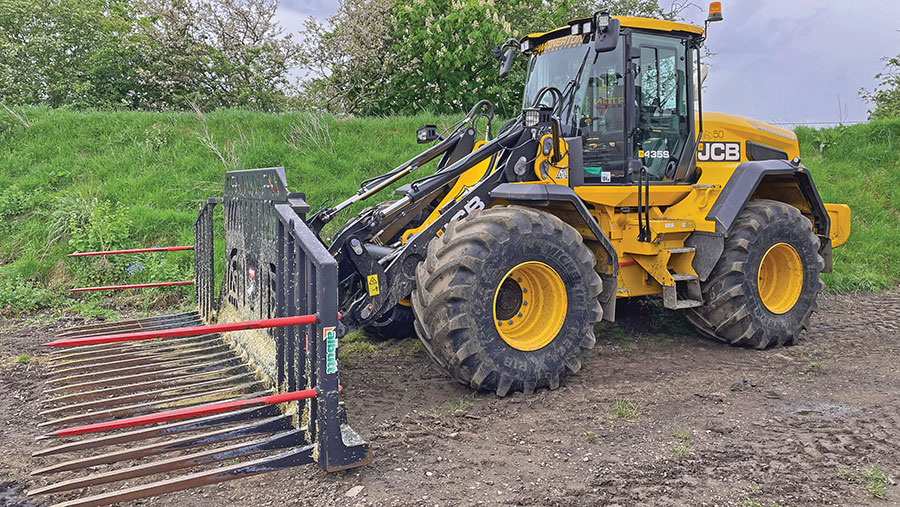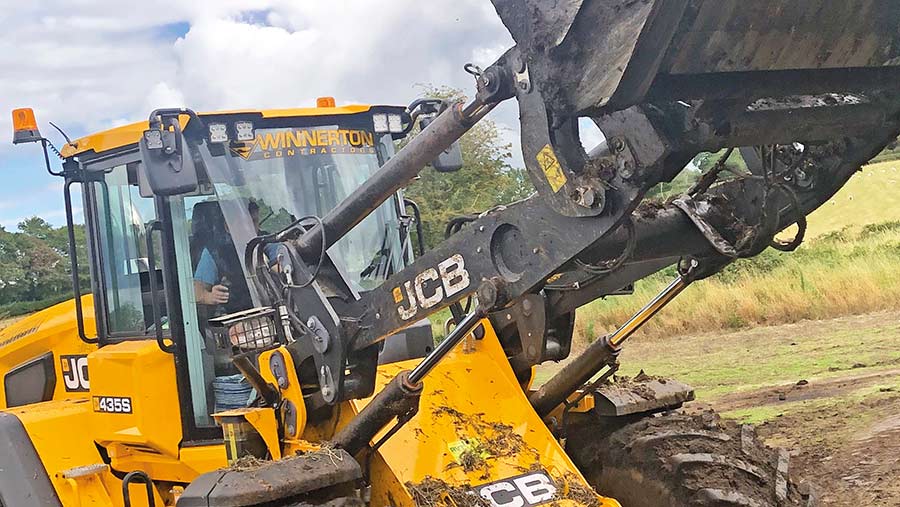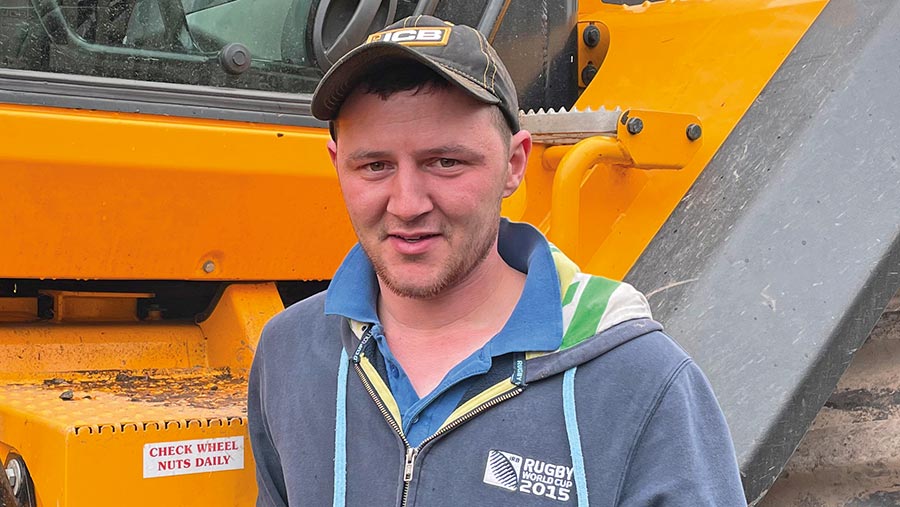Driver’s view: Swinnerton Agricultural Contractors’ JCB 435S
 © James Andrews
© James Andrews We get the lowdown on the 435S loading shovel run by Shropshire contractor Mikey Swinnerton.
Mikey Swinnerton runs a contracting business that centres around the needs of dairy farmers and anaerobic digesters in Newport, Shropshire, and the surrounding area.
To deal with the large volumes of grass, maize and wholecrop on his patch, his forage harvester of choice is a 790hp Claas Jaguar 970 with a 12-row maize header and 3m grass and wholecrop headers.
It is supported by a fleet of 16t and 22t trailers, so when the operation is in full swing there is a good quantity of grass coming into the clamp.
Business facts
Swinnerton Agricultural Contractors, Newport, Shropshire
- Business – Full grass service, maize and beet drilling, slurry spreading, baling and drilling
- Drivers – Jamie McCoskry and George Lewis
Handling that workload is a 2020 JCB 435S loading shovel, which is Mr Swinnerton’s third machine from the Staffordshire manufacturer.
The first was a 416 that arrived about 10 years ago to replace a tractor and buckrake.
“It was more of a yard loader than a machine for climbing the clamp, and when you pushed it into a heavy load it would just rev and sit there,” he says.
“We ran it four or five seasons before upgrading to a 435S, which was a completely different animal.”
That machine also worked five seasons and clocked up 5,500 hours before being replaced with this Stage 4b model, which he chose over the current Stage 5 version as it was considerably cheaper.
“I think we nabbed one of the last build slots and it set us back about £150,000, including a 16ft Albutt fork.”
See also: Video: Fendt’s debut Cargo T955 telehandler on test

This 435S is the third JCB loading shovel owned by Swinnerton Ag Contractors © Jamie McCoskry
JCB 435S stats
- Year 2020
- Hours 1,700
- Engine 6.7-litre, six-cylinder Cummins
- Maximum power 230hp@1,600rpm
- Maximum torque 945Nm@1,500rpm
- Diesel tank 400 litres
- Transmission Six-speed powershift with torque lock-up
- Hydraulic pump Twin pumps: 130 and 160 litres/min
- Tipping load (straight) 10,999kg
- Weight 14,355kg
- Turning circle 11.8m
- Ground clearance 491mm
- Price paid £150,000 (including buckrake)
How has it performed?
It is kept busy most of the year, building silage clamps in spring, summer and autumn and loading muck through the winter.
On the clamp, it just feels like it wants to push hard and, if the conditions are right, it will take a 19t trailer load up in one hit.
Generally, we run it in second gear and it only needs to be dropped into first if it’s a particularly heavy crop.
If we do overload it, it tends to spin the wheels and dig holes before the engine or transmission show any signs of slowing down.
One thing we have noticed is that it operates at surprisingly low engine revs compared with the old model.
The hydraulics are also far more responsive and there is no delay when pushing into a load and doing the first lift, even though we have a 0.6m wider fork.
This time we decided to try an Albutt model running Hardox tines, as we had some problems with the bushes wearing on the old Strimech one.
This caused the wings to sag and the outside tines would wear away; we tried to reinforce them, but never managed to stop it happening.

Operator Jamie McCroskry © James Andrews
When the shovel moves on to loading the muckspreaders, we fit it with a big Albutt toe-tip bucket that’s almost 3cu m. It handles this easily and the only limiting factor is keeping the rear wheels on the ground.
As for the cab, it’s far smarter than before, which makes it a much nicer place to work.
The biggest improvement was moving the joystick from the side console to the seat, but the control layout is also neater and there is an electric handbrake that has made space for a fridge next to the driver’s seat.
Better adjustment of the steering wheel also means it is easier to find a comfortable seating position.
It’s now worked about 1,700 hours and there have been no major issues.
The dealer has had to come out to it several times for niggly problems with the AdBlue system, but that just seems to be the way with modern machinery.
What could be improved?
There is not a lot to dislike about it, which is probably why JCB has done so well with it. It’s heavy, powerful, has loads of torque and is nice to drive, which is all you need from a shovel.
The only real comments we have (other than the AdBlue problems) are in the cab. It’s clearly a big step up from the previous version, but there are a couple of slightly annoying features.

The cab is praised for comfort but the rear camera feed (top right) could be better positioned © James Andrews
Firstly, JCB changed the door so it hinges from the front rather than the rear, which is far less handy for hopping in and jumping out.
We think the company did it to make it easier to climb up to the engine bay, but we rarely need to access that area.
Also, there is now a screen in the top right of the cab that houses most of the readouts and the feed from a camera that’s integrated into the bonnet.
This is a nice idea, but the camera isn’t anywhere near your eyeline and it’s actually more of a distraction than a help – particularly as it flashes in the corner of your eye every time you shift into reverse.
On the old model we had a camera mounted near the dash, which was far more useful.
Would you have another?
It’s still early days for this machine but, based on the performance of the old 435S, I can’t see why we wouldn’t have another.
Our dealer, Rea Valley Tractors, is also very convenient and backs us up well, so there has never been any need for us to get a rival machine out on demo.
Likes and gripes
Likes
- Loads of power and torque
- Fast hydraulics
- Operates at low engine revs
Gripes
- Niggles with the Adblue system
- Restricted cab access
- Poor screen positioning

